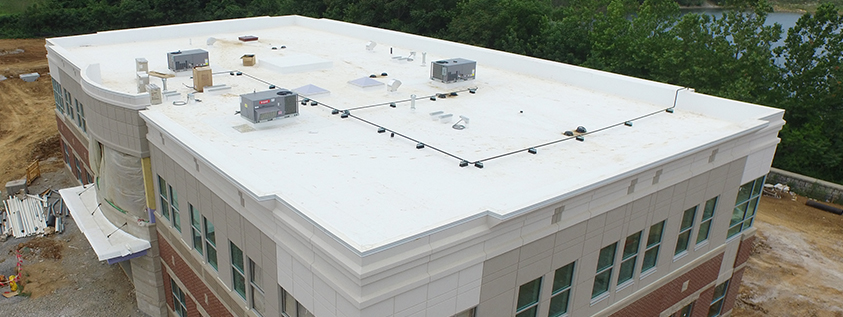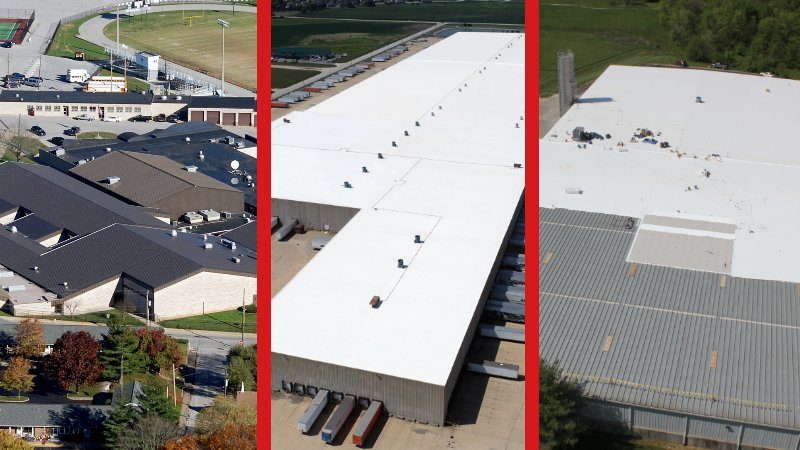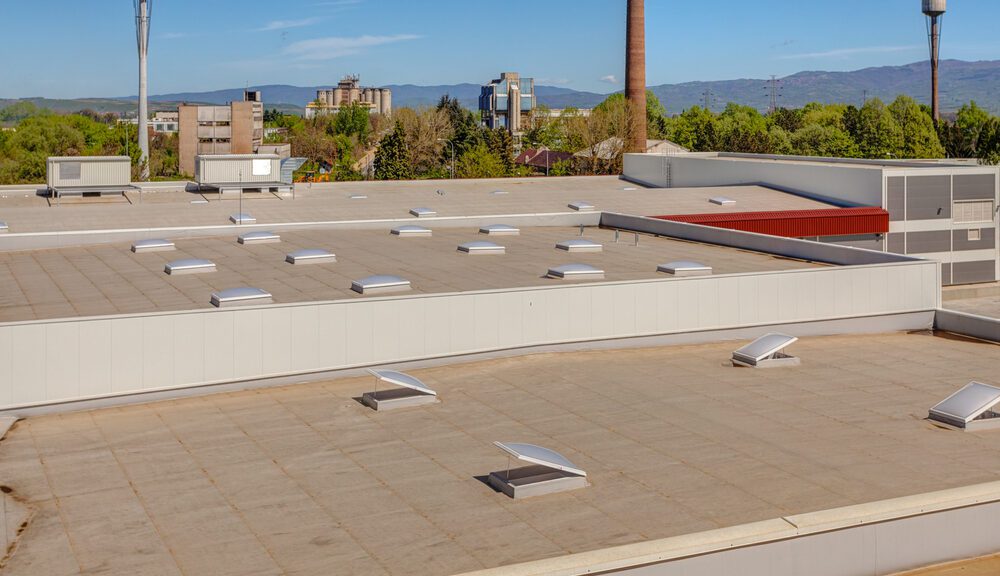Thinking about the type of roof for your commercial building? It’s an important decision that can have a significant impact on both the aesthetic appeal and functionality of your property. With a wide range of options available, from flat roofs to sloped roofs, it’s essential to consider factors such as weather conditions, building size, and maintenance requirements. By understanding the different types of roofs and their advantages, you’ll be able to make an informed choice that ensures your commercial building remains both durable and visually appealing.
1. Factors to Consider
When it comes to choosing the right roof for your commercial building, there are several important factors that you need to take into consideration. These factors will not only impact the initial installation cost but also the long-term durability and energy efficiency of your roof.
1.1 Climate and Weather Conditions
The climate and weather conditions of the area where your commercial building is located play a significant role in determining the type of roof that is suitable for your needs. For example, if your area experiences heavy rain or snowfall, you’ll need a roof that is designed to withstand these types of weather conditions. On the other hand, if you’re in a hot and sunny climate, you’ll want a roof that can provide adequate insulation and reflectivity to keep your building cool.
1.2 Building Design and Structure
The design and structure of your commercial building can also influence the type of roof that is most suitable. Factors such as the slope of the roof, the size of the building, and the presence of any architectural features like skylights or roof hatches need to be considered when selecting a roofing system. Certain roofing materials may not be compatible with certain building designs, so it’s important to consult with a professional to determine the best option for your specific needs.
1.3 Energy Efficiency
Energy efficiency is becoming an increasingly important factor in commercial building design and construction. A well-insulated and energy-efficient roof can help reduce heating and cooling costs, making your building more sustainable and cost-effective in the long run. Consider the insulation properties and reflectivity of different roofing materials to determine which will provide the best energy efficiency for your commercial building.
1.4 Durability and Longevity
Commercial buildings are subject to heavy wear and tear, so choosing a durable and long-lasting roofing system is crucial. Consider the anticipated lifespan of different roofing materials and their resistance to common issues like cracks, leaks, and damage from weather elements. Investing in a high-quality and durable roof upfront can save you from costly repairs and replacements down the line.
1.5 Maintenance Requirements
Different roofing materials have varying maintenance requirements. Some materials may require regular inspections, cleaning, and repairs to ensure their longevity and performance. Consider the resources and budget you have available for ongoing roof maintenance and choose a roofing system that aligns with your capabilities and requirements.
2. Types of Commercial Roofs
Now that you understand the important factors to consider, let’s explore the various types of commercial roofs available. Each roofing system has its own advantages and disadvantages, and it’s important to evaluate them based on your specific needs and priorities.
2.1 Built-Up Roofing (BUR)
Built-Up Roofing (BUR) is a traditional roofing system that consists of multiple layers of bitumen and reinforcing fabrics. It is known for its durability and resistance to extreme weather conditions. BUR roofs are commonly used in flat or low-slope commercial buildings and can provide excellent protection against water infiltration.
2.2 Modified Bitumen Roofing
Modified Bitumen Roofing is a type of BUR system that incorporates added modifiers to enhance its properties, such as increased elasticity and resistance to temperature extremes. This roofing system is highly durable and can withstand heavy foot traffic and mechanical stress. It is commonly used in commercial buildings with moderate slopes.
2.3 Thermoset (EPDM) Roofing
Thermoset (EPDM) Roofing is a single-ply rubber membrane that offers excellent resistance to UV rays, ozone, and weathering. It is easy to install and repair, making it a popular choice for commercial buildings. EPDM roofing is also known for its durability and is resistant to tears, punctures, and abrasions.
2.4 Thermoplastic (PVC and TPO) Roofing
Thermoplastic (PVC and TPO) Roofing systems are highly reflective and energy-efficient. These single-ply membranes provide excellent resistance to chemicals, UV rays, and punctures. PVC roofing is known for its superior fire resistance, while TPO roofing offers improved flexibility and heat-weldable seams.
2.5 Metal Roofing
Metal roofing systems are known for their durability, longevity, and aesthetic appeal. They can be made from various materials such as steel, aluminum, or copper, and are available in different styles, including standing seam, corrugated panels, and metal tiles. Metal roofs are highly resistant to fire, wind, and impact, making them a popular choice for commercial buildings.
2.6 Green Roofing
Green roofing, also known as living roofs or vegetative roofs, are becoming increasingly popular due to their environmental benefits. These roofs are covered with vegetation, providing insulation, reducing stormwater runoff, and improving air quality. Green roofs require specific design considerations and maintenance, but can be a great option for sustainable commercial buildings.
2.7 Solar Roofing
Solar roofing systems integrate solar panels into the roof surface, allowing for the generation of electricity from the sun’s rays. These systems can help offset energy costs and reduce greenhouse gas emissions. While the initial installation cost may be higher, solar roofing can provide long-term energy savings and environmental benefits.
2.8 Shingle Roofing
Shingle roofing is a cost-effective option commonly used in residential buildings, but it can also be suitable for certain types of commercial buildings. Asphalt shingles are the most popular choice, offering durability, affordability, and versatility in terms of color and style.
2.9 Single-Ply Membrane Roofing
Single-ply membrane roofing systems are lightweight and flexible, making them easy to install and repair. They are available in various materials, including PVC, TPO, and EPDM, and can provide excellent protection against leaks and UV rays. Single-ply membranes are commonly used in commercial buildings with flat or low-slope roofs.
2.10 Spray Polyurethane Foam (SPF) Roofing
Spray Polyurethane Foam (SPF) roofing is a unique system that involves spraying a mixture of liquid chemicals onto the roof surface, where it expands and forms a seamless insulation layer. SPF roofing provides exceptional insulation, waterproofing, and energy efficiency. It can be suitable for commercial buildings with irregular roof shapes or those requiring additional insulation.

3. Cost Considerations
When it comes to the cost of a commercial roof, several factors come into play. Understanding the different cost considerations can help you make an informed decision.
3.1 Installation Costs
The installation costs of a commercial roof vary depending on the type of roofing system, the size and complexity of the building, and the labor involved. Some roofing materials, such as metal or spray foam, may require specialized installation techniques and equipment, which can increase the overall cost. It’s important to obtain multiple quotes from reputable roofing contractors to understand the range of installation costs for your chosen roofing system.
3.2 Maintenance Costs
Different roofing materials have varying maintenance requirements, which can impact long-term costs. Some materials may require regular inspections, cleaning, or repairs, which can incur additional expenses over time. It’s important to consider ongoing maintenance costs when evaluating the overall cost of a roofing system.
3.3 Energy Efficiency and Savings
Energy-efficient roofing systems, such as those with high insulation properties or reflective surfaces, can help reduce heating and cooling costs. While these systems may have a higher upfront cost, they can provide long-term energy savings, resulting in lower utility bills. It’s important to consider the potential energy savings and return on investment when evaluating the cost of a roofing system.
3.4 Long-term Return on Investment (ROI)
When considering the cost of a commercial roof, it’s important to look beyond the initial installation cost and consider the long-term return on investment. A higher-quality and more durable roofing system may have a higher upfront cost but can provide significant savings in terms of maintenance, repairs, and energy efficiency over its lifespan. It’s important to evaluate the overall cost-effectiveness and lifespan of different roofing materials to determine the best option for your commercial building.
4. Environmental Impact
In an era where environmental sustainability is a growing concern, considering the environmental impact of your commercial roof is essential. Here are some key factors to consider:
4.1 Sustainability
Sustainable roofing materials are those that are made from recycled or renewable resources, have low embodied energy, and can be recycled at the end of their lifespan. Choosing sustainable roofing options can help reduce the environmental footprint of your building and contribute to a greener future.
4.2 Energy Consumption
Roofing materials that have high insulation properties or reflect a significant amount of solar radiation can help reduce the energy consumption of your building. By reducing the need for excessive heating or cooling, you can lower your carbon footprint and contribute to energy conservation efforts.
4.3 Recycling and Disposal
When it comes time to replace or repair your commercial roof, it’s important to consider the recyclability and proper disposal of the roofing materials. Some materials, such as metal or single-ply membranes, can be easily recycled, while others may need to be disposed of in accordance with local regulations. Choosing materials that can be recycled or have minimal environmental impact during disposal can help reduce waste and promote sustainable practices.

5. Roofing Materials Comparison
To further assist you in making an informed decision, let’s compare the various roofing materials based on different factors:
5.1 Pros and Cons of Each Material
Each roofing material has its own advantages and disadvantages. For example, built-up roofing offers excellent durability but may require regular maintenance, while metal roofing is highly durable but can be more expensive upfront. It’s important to evaluate the pros and cons of each material based on your specific requirements.
5.2 Lifespan and Longevity
The lifespan of a roofing material is an important consideration when evaluating its cost-effectiveness. Some materials, such as metal or green roofing, can have a significantly longer lifespan compared to others like asphalt shingles. Considering the expected lifespan of the material can help you determine the long-term value of your investment.
5.3 Maintenance Requirements
Different roofing materials have varying maintenance requirements. Some materials may need regular inspections, cleaning, or repairs to ensure their durability and performance. Understanding the maintenance requirements of each material can help you plan for ongoing maintenance costs and ensure the longevity of your roof.
5.4 Energy Efficiency and Insulation
Energy-efficient roofing systems can help reduce your building’s energy consumption and contribute to a more sustainable operation. Materials with high insulation properties or reflective surfaces can provide better insulation and reduce the need for excessive heating or cooling. Evaluating the energy efficiency and insulation properties of each material can help you choose a roofing system that aligns with your environmental goals.
5.5 Cost Considerations
Cost is a significant factor in any decision-making process. While some roofing materials may have a higher upfront cost, they may provide long-term cost savings in terms of maintenance, repairs, and energy efficiency. It’s important to evaluate the overall cost-effectiveness of each material based on your budget and priorities.
6. Roofing System Components
A commercial roofing system consists of several components that work together to provide protection and durability. Let’s take a closer look at these components:
6.1 Insulation
Roof insulation plays a crucial role in energy efficiency and thermal comfort within a commercial building. It helps regulate temperature, minimize heat loss or gain, and reduce energy consumption. Different types of insulation, such as rigid board, sprayed foam, or fibrous materials, can be used depending on the specific requirements of the roofing system.
6.2 Vapor Retarders
Vapor retarders are materials installed within a roofing system to prevent the movement of moisture from warm areas to cool areas, reducing the risk of condensation and potential damage. They help maintain the integrity of the roofing system, enhance energy efficiency, and prevent moisture-related issues.
6.3 Roof Membranes
Roof membranes are the primary waterproofing layer of a commercial roofing system. They provide protection against water infiltration and damage, making them a crucial component. Membranes can be made of different materials such as EPDM, PVC, TPO, or modified bitumen, depending on the chosen roofing system.
6.4 Flashings and Edge Details
Flashings and edge details are components that help prevent water from seeping into vulnerable areas of the roofing system, such as joints, corners, or edges. Properly installed flashings and edge details are essential for maintaining the integrity and longevity of the roof.
6.5 Roof Drainage Systems
Roof drainage systems, including gutters, downspouts, and drains, are responsible for directing water away from the roof surface and preventing water buildup. Adequate roof drainage is essential to ensure the longevity and effectiveness of the roofing system, as it helps prevent leaks and potential structural damage.
6.6 Skylights and Roof Hatches
If your commercial building requires natural lighting or access to the roof, skylights and roof hatches can be incorporated into the roofing system. These components should be carefully designed and installed to ensure they do not compromise the waterproofing and insulation properties of the roof.
6.7 Roof Coatings
Roof coatings can be applied to enhance the durability, waterproofing, and reflectivity of a commercial roof. Coatings can extend the lifespan of the roofing system, improve energy efficiency, and provide protection against UV radiation and weathering. The type and application of roof coatings depend on the specific roofing material and its intended purpose.

7. Building Codes and Regulations
Compliance with building codes and regulations is essential when installing or repairing a commercial roof. Here are some key considerations:
7.1 Fire Ratings and Resistance
Different roofing materials have varying fire ratings and resistance. Depending on your commercial building’s occupancy type, local regulations may dictate specific fire ratings for the roofing system. It’s important to ensure that your chosen roofing material meets the necessary fire safety requirements.
7.2 Wind Uplift Resistance
Commercial roofs need to be designed and installed to withstand strong winds and potential uplift forces. Local building codes may specify minimum wind uplift resistance requirements for different roof types and locations. Ensuring that your commercial roof meets these requirements is essential for safety and durability.
7.3 Energy Codes and Compliance
Many jurisdictions have energy codes in place to promote energy efficiency in commercial buildings. These codes may include requirements related to insulation, reflectivity, or air leakage. Understanding and complying with these energy codes can help you achieve a more sustainable and efficient roofing system.
7.4 Roofing Permits and Inspections
Roofing projects often require permits and inspections to ensure compliance with local building codes and regulations. Working with a qualified roofing contractor who is familiar with the permitting process can help ensure a smooth and compliant installation or repair process.
8. Choosing the Right Roofing Contractor
Selecting a reputable and experienced roofing contractor is crucial to the success of your commercial roofing project. Here are some key factors to consider when choosing a contractor:
8.1 Experience and Expertise
Look for a roofing contractor with extensive experience in commercial roofing projects. They should have a proven track record and expertise in working with the specific roofing materials and systems you are considering. Ask for references and past project examples to evaluate their capabilities.
8.2 Licensing and Insurance
Ensure that the roofing contractor holds the necessary licenses and insurances required by your local jurisdiction. This helps protect you from liability and ensures that the contractor meets the necessary safety and quality standards.
8.3 References and Past Projects
Ask for references from the roofing contractor and take the time to contact their previous clients. Inquire about their satisfaction with the contractor’s workmanship, professionalism, and adherence to timelines and budgets. Checking out past projects can give you an idea of the quality of their work and their ability to deliver on your expectations.
8.4 Warranty and After-sales Service
A reputable roofing contractor should provide warranties on their work and the roofing materials used. Understand the details of these warranties, including their duration, coverage, and any exclusions. Additionally, inquire about their after-sales service and support in case any issues arise after the completion of the project.
8.5 Price and Bids
While cost should not be the sole determining factor, it’s important to obtain multiple bids from different contractors to ensure you are getting a fair price for the quality of work. Be cautious of extremely low bids, as they may indicate subpar materials or workmanship.
In conclusion, choosing the right roof for your commercial building is a complex decision that requires careful consideration of several factors. It’s crucial to evaluate the climate and weather conditions, building design, energy efficiency, durability, and maintenance requirements. Additionally, cost considerations, environmental impact, roofing material comparison, roofing system components, building codes and regulations, and selecting the right roofing contractor are all important aspects to take into account. By thoroughly evaluating each of these factors and seeking professional advice, you can make an informed decision that best suits the needs of your commercial building.